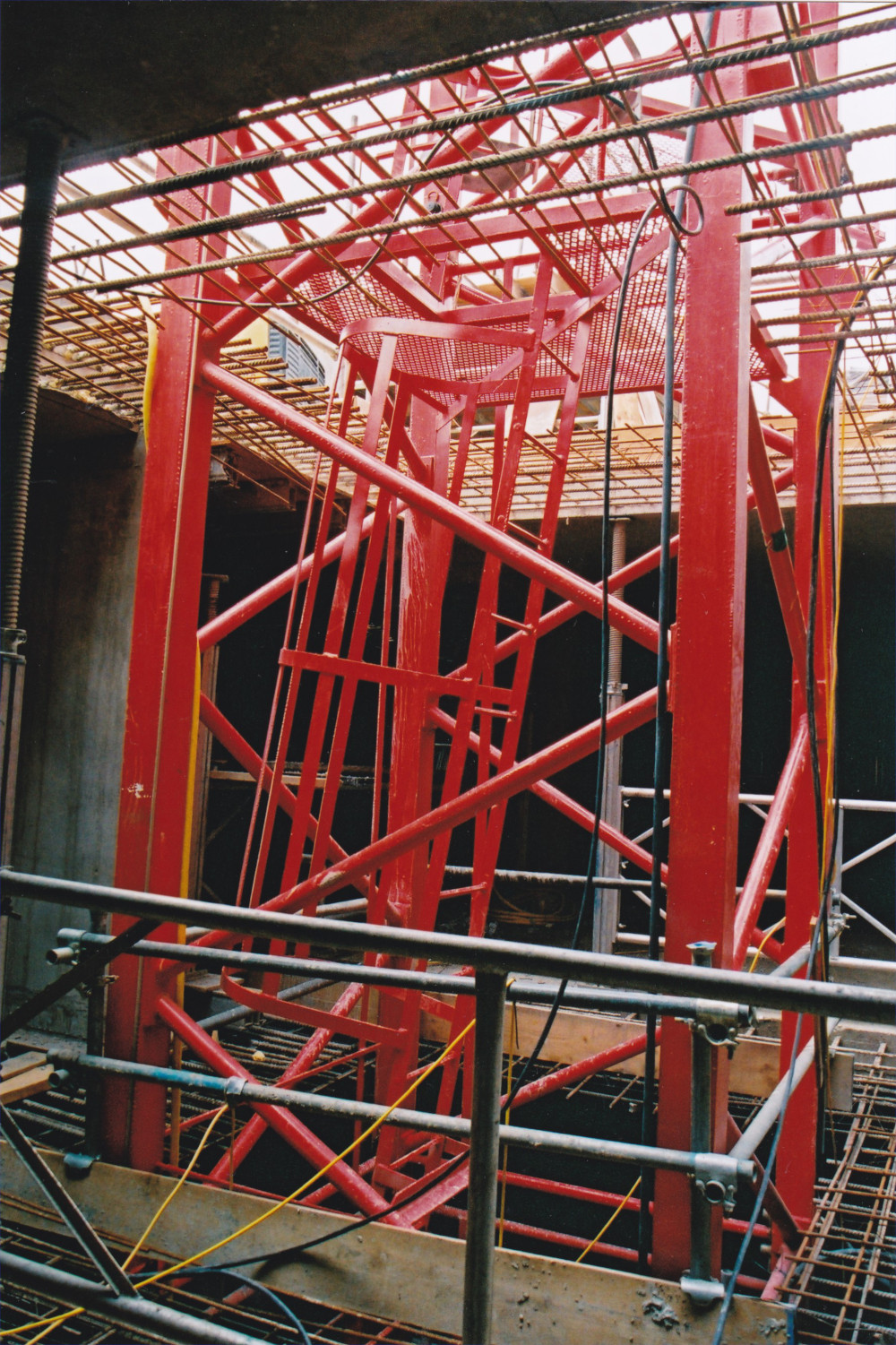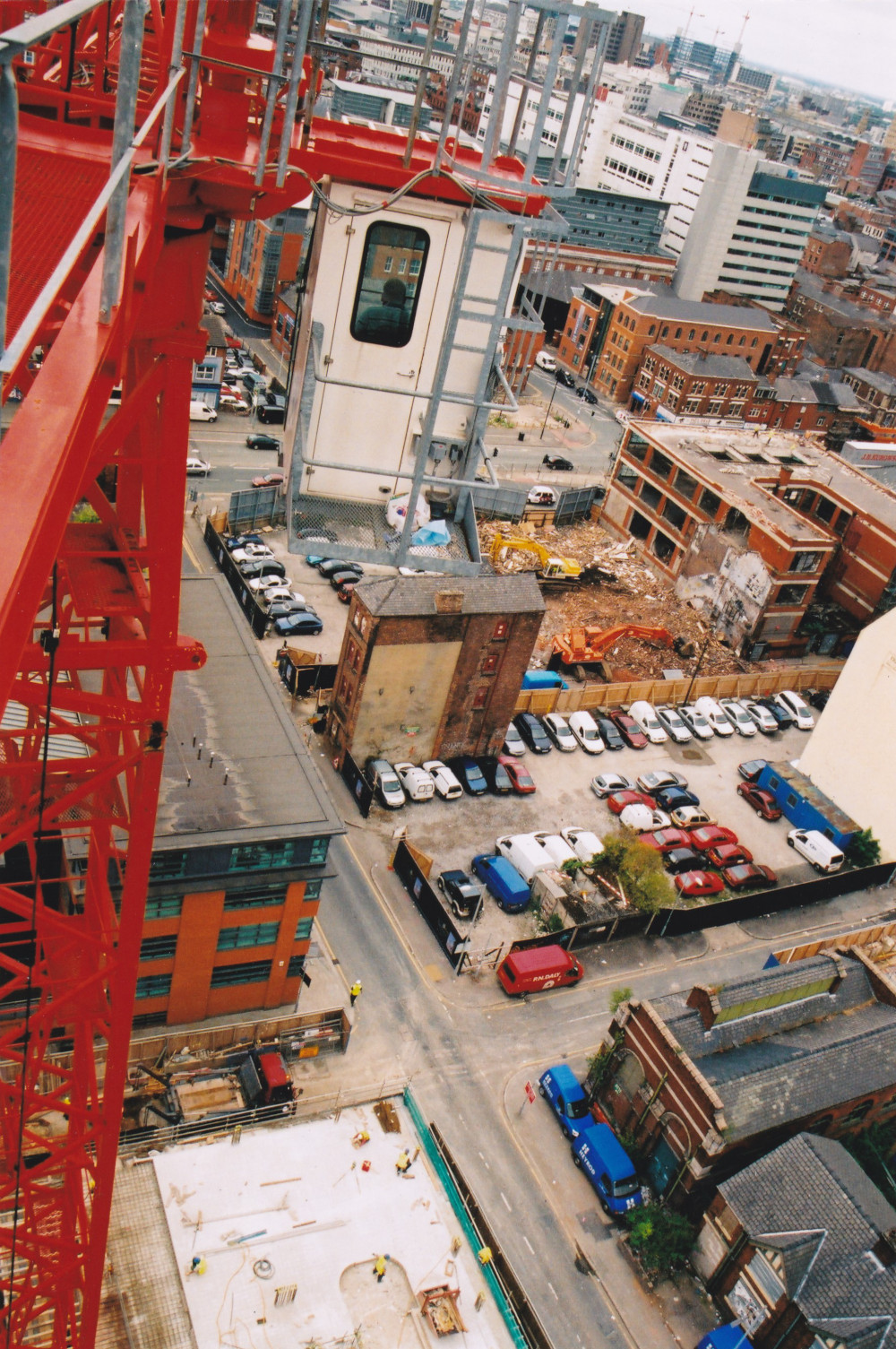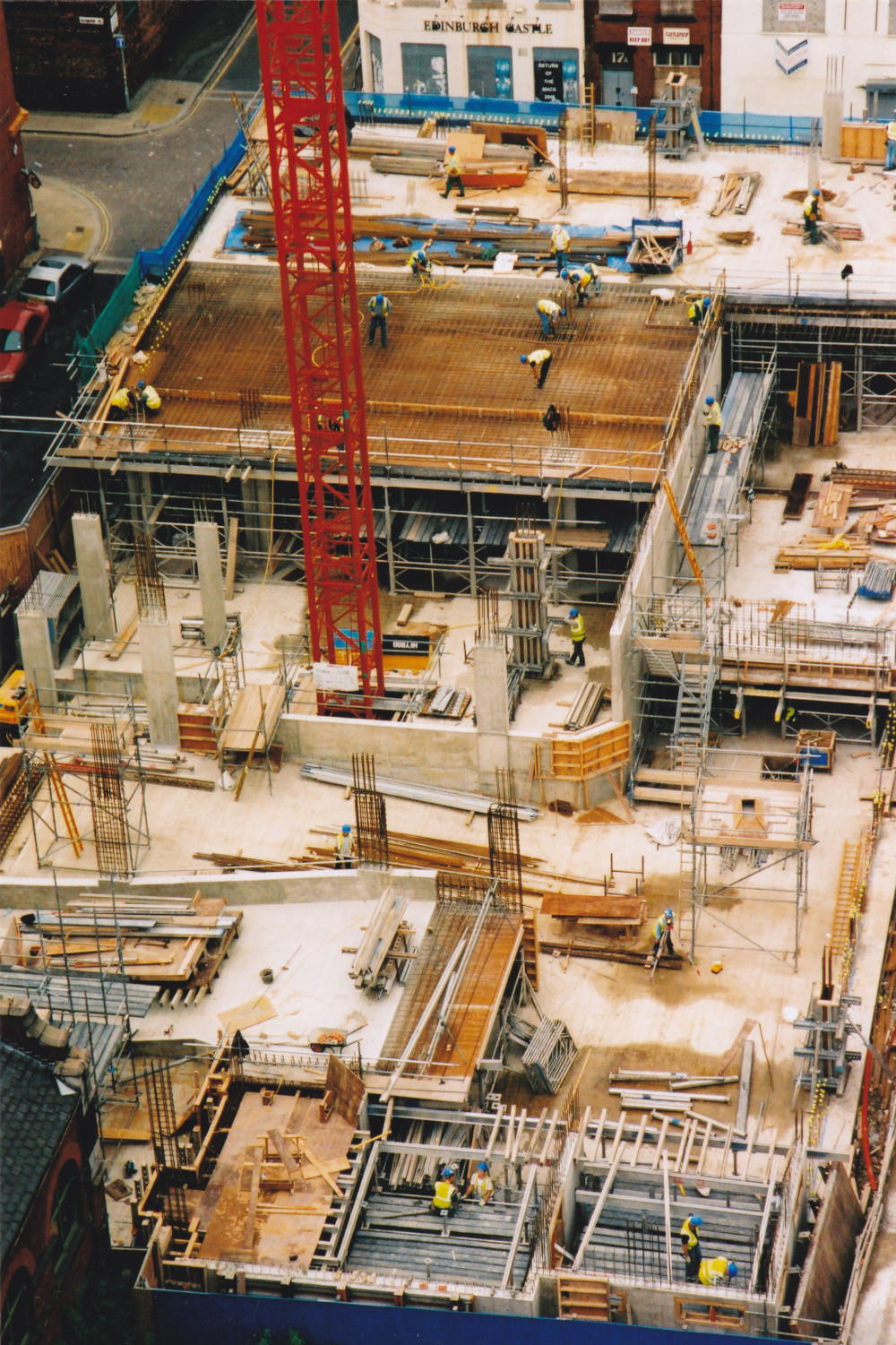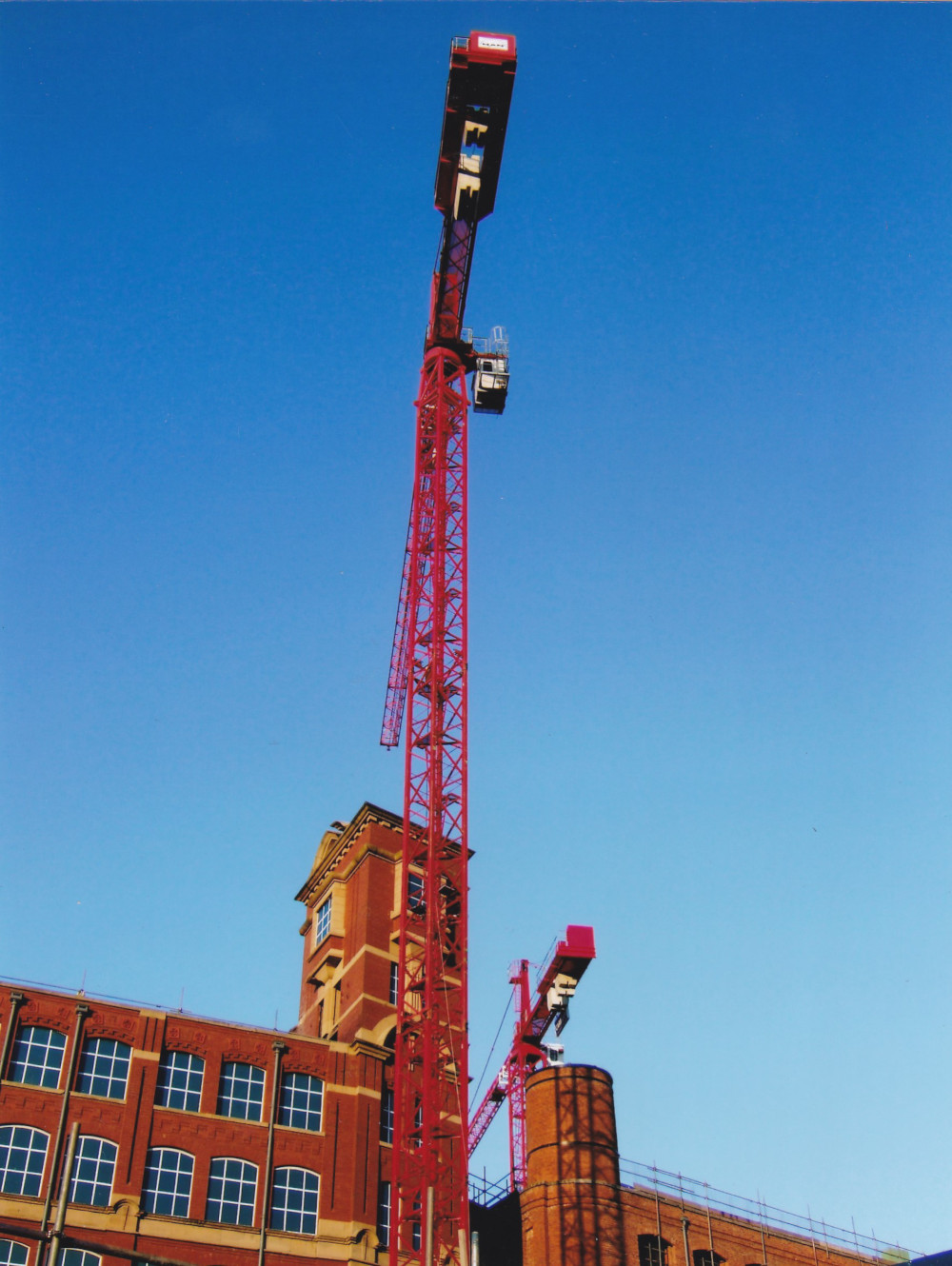


Buddleia growing out of the roof of Loom Street Mill was flaying around in the breeze. It made me nervous. If the wind were blowing, the crane would be swaying, around its anchor point in the clay beneath the concrete of the construction site. I hadn’t experienced any difficulties with heights before. Spending time on the top of Murrays’ Mills’ roofs, and on scaffolding above the top of Royal Mills had hardened me to working at height.
But this height was a little different. Twice as high as the five-storey mill building, the cab of the tower-crane serving Royal Mills is gained by a series of open ladders welded to a floor and roof frame 1.75 metres square. Each laddered segment is stacked on top of the next to make a stanchion 60 metres high. The landings are diamond grids, through which the ground below is visible. Sparsely spaced safety bars are just enough to stop a fall to the ground, should you slip on the rungs of the ladders. But there is no protection for an over active imagination picturing the slipping foot, the lost handhold, and the subsequent fall.
Looking up the stanchion of the crane I felt confident about getting as far as the height of the mill roof on the red frame. But to continue climbing to double that height – I really had no idea how I would react. Just keep steadily climbing, concentrate on the ladder, look neither up nor down.
I had expected to be climbing alone. I really wanted to do it alone, but Glyn, the health and safety officer, was to accompany me. At the beginning of our climb I was given a choice: I could stare at his bum all the way up, or he could stare at mine. I chose the later. This was the only way I would get any feeling of doing this alone.

Ascent begins with a descent. The base of the crane begins 4 metres below basement level of the excavations for the apartment block with its underground car park. Once the crane has finished its work, its superstructure is dismantled, but its foundations remain within the sub-core of the building it has taken part in the making of.
We located the first ladder comprising ten rungs and began the ascent. It took a couple of stages to get us above ground and into the rhythm that would take us all the way up to the cab at the top.
Within the shelter of Royal Mills the breeze was slight and warm. Once above the height of the building, it stiffened a little. From here on I was climbing above everything around me – tiny little being slowly moving up through the skeleton of fragile metal members. I steadied my pace, concentrated my vision on the rungs immediately before my eyes, and used the repetitive movement of my body to keep me focused on each stage I needed to work through.
Very soon into the climb, much sooner than I had expected, the jib caught my eye. Don’t think about how high you are from the ground. Keep going until you are able to stand on the horizontal beam. Even more quickly I found myself mounting the final stage, and walked out onto the main beam that counterbalanced the lifting section of the crane. Hanging on to the safety rails I relaxed and started to take in the view around me, feeling thrilled that I had made it while appreciating one of the skills of the crane operative.
Feet snuggled down in a pair of white socks belonged to the crane operator who was sitting in the cab just down from where I was standing – nothing but fresh air beneath this compact compartment. But then how else was he going to be able to do his job if his view was hindered in any way? Once I had oriented myself I asked Glyn if I could go down into the cab. I would have to climb out onto a small landing stage attached to the cab at the bottom of a ladder, this stage too just a mesh with nothing between it and the ground below.
It seemed a little absurd, but I thought it only polite to knock on the cab door. The operator swivelled round in his chair and let me in. I wasn’t expecting him to refuse, but this was his domain and I needed to be invited in. “Come in. I don’t get many visitors up here.” He was very generous, since having me in his cab would make it difficult for him to work – I would be interrupting his concentration. After being greeted, Lee, the operator, blushed slightly, and apologised for the wallpaper – a colourful array of well-rounded female forms whose voluptuous bodies I was very envious of – spread-wide thighs, glossy pink yonis, and full breasts pushing themselves out into the world with pride and glee. I had asked to visit and was happy that I had been allowed into this very private of working domains. I didn’t mind in the least that these handsome women had been chosen to play such an important part in the working life of the crane operator.
Lee sat in a black swivel chair managing the operations that were taking place 60 metres below him. In the arms of the chair, at the very ends, were two joysticks. They operated the height of the lifting gear, its position along the horizontal arm of the crane, and the swing position of the jib with 360-degree access to the site below.

It was through a radio that Lee joined the grounded construction community. Every time instructions were passed either way, the cacophony of the site accompanied the bankman’s communication – a remote way to stay connected from the aloftness of the job. Large grids of metal reinforcing for the concrete floors being poured, metal beams used for support during pouring, rang out large harsh rings as they found there place in the structure they were helping build. Shouts of instruction from one worker to the next interspersed grating clangs. The piercing scream of sandblasting operations hissed for long unbroken sessions, sometimes making the radio instructions difficult to hear. Lee had no problem, attuned to the sound of the bankman’s voice, anticipating the moves he requested, as the next layer of the grid was manoeuvred into place.
I don’t know how connected Lee wanted to be to the site, how important it was for him to be closer to his work team other than through his radio. “Nice and quiet up here. I’ve got a heater – all that I need. Like to keep my cab clean, keep the windows clean. It’s my office.” I was surprised when he told me that some crane operators don’t share his need to work in a clean environment. If you can’t see out of the windows, how can you manoeuvre loads around site?
Floor to ceiling vertical windows of the cab gave uninterrupted views onto the construction site and a long way beyond. Blinds, rolled up on this dull day, could be pulled down to shield eyes from the sun. These were the only forms of air conditioning the cab had, other than open windows. The fridge in which to keep lunch chilled was the grid floor of the access platform to the cab just outside the door. There was music, set at a volume that wouldn’t interrupt the operator’s vocal communication with the ground, but loud enough to keep him company. He turned it off when I went into the cab, so that we could chat.
Lee enjoyed his work. He had paid around £3000.00 for his training – a sound investment. As we looked out over the top of the Manchester skyline he pointed out the other cranes he had worked with, one far taller than the one we were on.
Over the last few months I have been very much earth bound working with the ground workers in Murrays’ Mills basements, leaving them for only a short while to join the scaffolding team. The crane took me up to another layer of construction, both in technique and the environment these seemingly flimsy metal structures operate in. Lee wasn’t alone. Just a short distance away on the same site was another crane. And across the road, yet another, the operator having quite recently helped police track a mugger through the streets of Ancoats.
Lee and I chatted for a while as he continued with his work. We turned through the air as more supporting beams were moved from storage to the lift shaft being constructed beneath us. Coming to a halt after a swing, the whole body of the crane would sway slightly, taking time to settle. During these times there was little sense of connection with the earth below, the vertical support of the crane rising from the ground hidden by the cab.

I felt I should give Lee a break from my questions and left him for a while to climb back up to the horizontal bar that housed the lifting gear. There were safety rails all the way along the 10 metres of the arm to the drum around which the lifting cable wound. Underneath the drum three tons of concrete were attached to the jib – counterbalance to the maximum weight the tower crane was built to lift. I walked out to the drum getting used to the drop below. As I took up a position at the remote end of the beam, the crane moved, and I swung round 190 degrees in a broad three quarter turn. Quite a ride– almost imperceptible to begin with. I noticed it not by myself moving, but the roofs of the mills below curving an arc below me.
Needless to say the views must have been the best in Manchester. But that seemed of little consequence. What was so absorbing was the sense of occupying a very different terrestrial space. Noise from below rises muffled. Above on the crane arm, the wind whistles – softly today – as on the open trail of a high mountain peak. The only mechanism that makes an urban sound is the hum of the electric motor coming into action as it rotates the drum to let out or wind in the metal cable of the lifting gear. This is the sound that connects this crane with the others working in Ancoats.
Sometimes the graceful horizontal arms of this elite community swing in isolation, other times joined by a neighbour close by, or across the other side of the city. Together they occupy a thin sliver of the built environment, existing as a temporary segment of its evolution. The new city grows for them from beneath, up towards the height of the crane, rather than rising from the ground, and away into the air, as it does for the ground-based crews. The work of the crane makes massive structures, earthed deep within the ground, over which the working gear of the crane is suspended. Bar its tap, the rest of its connections are aerial rooted – taut thin steel cable lifting immense weights for short periods of time. Then gone– power and energy needed to make that connection terminated at the end of the lift. Hook, chains, cable and swing arm left free to rejoin the air they brought power and tension into briefly. Touching the ground with the strength and energy of lightening forks, dispersing as quickly into the ether, leaving behind material memory of its momentary existence in the substance of the building it makes.
Having travelled over most of the site, and watched the operations of both the crane and the ground workers it is a tool for, I being the descent, prolonging the thrill of the memory of the assent by stopping on the landings to watch the ground move closer. At ground level I moved from the crane’s aerial stance, to its subterranean root. It seemed entirely appropriate to carry the descent below ground level. From here I could rejoin my terrestrial existence.
August 29th 2005
I visited Lee again yesterday, in the rain. It was a drenching mizzle that coated every surface with its moisture. My gloves quickly became soaked, their fingers stretched by the weight of the water flapping themselves around the rungs of the ladders as I climbed. The metal was slippery. My nervousness made the climb slower than last time. I needn’t have made this assent. There were details about terms used to describe crane structure I needed clarifying, but they could have been done over the phone, or when Lee came down from his cab during a break. I just wanted an excuse to climb again.

The ‘summit’ arrived quickly, and I was welcomed into the little cab, warm and snug on this miserable morning. Lee was busy in conversation with his insurance brokers. His car had been broken into, badminton equipment and his sound-system stolen. I took this opportunity to take in the view from the cab. Conversation over, we chatted for a while. I showed Lee the photographs I had taken last time and he selected one or two he would like to have to show his family.
Lee had turned the radio off before he made his phone call. Into our chat he turned it back on again – to be admonished by the banksman for his lack of attention.
“Where have you been?”
I was amused at how odd that question felt. Not very far. You can’t hide easily in a cab two and a half meters square, 60 metres from the ground, with a glass floor and walls.
“Gary? Gary? I can hear you Gary. I’ve got a lady in my cab. She took some pictures.”
“Nice one.” Came Gary’s reply.
“What are you doing up there?” Steve, the crane operative, across the road on another site enquired.
“Never you mind Steve.” A grin accompanying Lee’s reply.
“He’s waving to you.” Lee pointed in the direction of the crane across the other side of Jersey Street. Steve and I exchanged waves across the space between the two tower cranes.
“She can take some great snaps from this crane if she wants.” – my invitation from Steve to visit his lofty post. I quite liked the idea of being runner for a community of tower-crane operatives.
Lee made his choice of photographs from the album I had taken up to show him. I gathered up my belongings before making the climb down, promising to be back with his copies. But before leaving I was treated to a full 360-degree tour of the site – floating like and angel, I imagined, over the workings of earth-bound man.
With thanks to Lee, Glyn and Ron at Royal Mills.